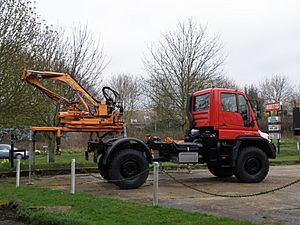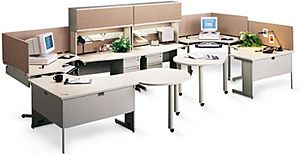Modular design facts for kids
Modular design is a smart way to create things by breaking them down into smaller, separate parts called modules. Think of it like building with Lego bricks! Each module can be made, changed, or replaced on its own. You can even swap modules between different systems. This makes products easier to build, fix, and upgrade.
Contents
What is Modular Design?
Modular design means making a system from smaller, independent pieces. These pieces are called modules. Imagine a puzzle where each piece is a module. You can take out one piece and put in a new one without changing the whole puzzle. This is how modular design works.
How Modules Work
Each module has a specific job. It can connect to other modules in a standard way. For example, a USB port on a computer is a module. You can plug in many different devices (like a mouse, keyboard, or printer) into the same USB port. This is because the USB port is a standard module.
Why is Modular Design Useful?
Modular design offers many cool benefits. It helps save money, makes things work better together, and allows for easy upgrades.
Saving Money and Time
When something is modular, you only need to change a small part if you want to customize it or fix it. You don't have to rebuild the whole thing. This saves a lot of money and time. For example, if a part of your modular phone breaks, you could just replace that one part instead of buying a whole new phone.
Easy to Learn and Use
Because modules are often standard, they are easier to understand and use. Once you learn how one module works, you can often use similar modules in other systems. This makes learning new technology much faster.
Flexible and Future-Proof
Modular designs are very flexible. You can add new features or upgrade old ones just by plugging in new modules. This means products can last longer and adapt to new technologies without becoming outdated. It's like adding new apps to your phone – you don't need a new phone every time a new app comes out!
Examples of Modular Design
You can find modular design in many things around you. It's used in everyday items and complex machines.
- Cars: Many car parts, like engines or stereo systems, are modules. Car companies can use the same "platform" (the basic structure) for different car models, just changing the modules.
- Computers: Parts like RAM, hard drives, and graphics cards are modules. You can easily upgrade these parts to make your computer faster or store more data.
- Furniture: Some furniture, like shelves or desks, is modular. You can add or remove sections to fit your space.
- Solar Panels: You can add more solar panels to your roof if you need more power. Each panel is a module.
- Wind Turbines: These giant machines are built with modular parts, making them easier to transport and assemble.
- Buildings: Some buildings are made from pre-built modules that are put together on site. This can make construction much faster.
Mass Production and Customization
Modular design is great for mass production. Companies can make many standard modules, which is cheaper. Then, they can combine these modules in different ways to create many different products. This allows for some customization without having to design each product from scratch. The more modular a system is, the more ways it can be customized.
See also
 In Spanish: Diseño modular para niños
In Spanish: Diseño modular para niños




